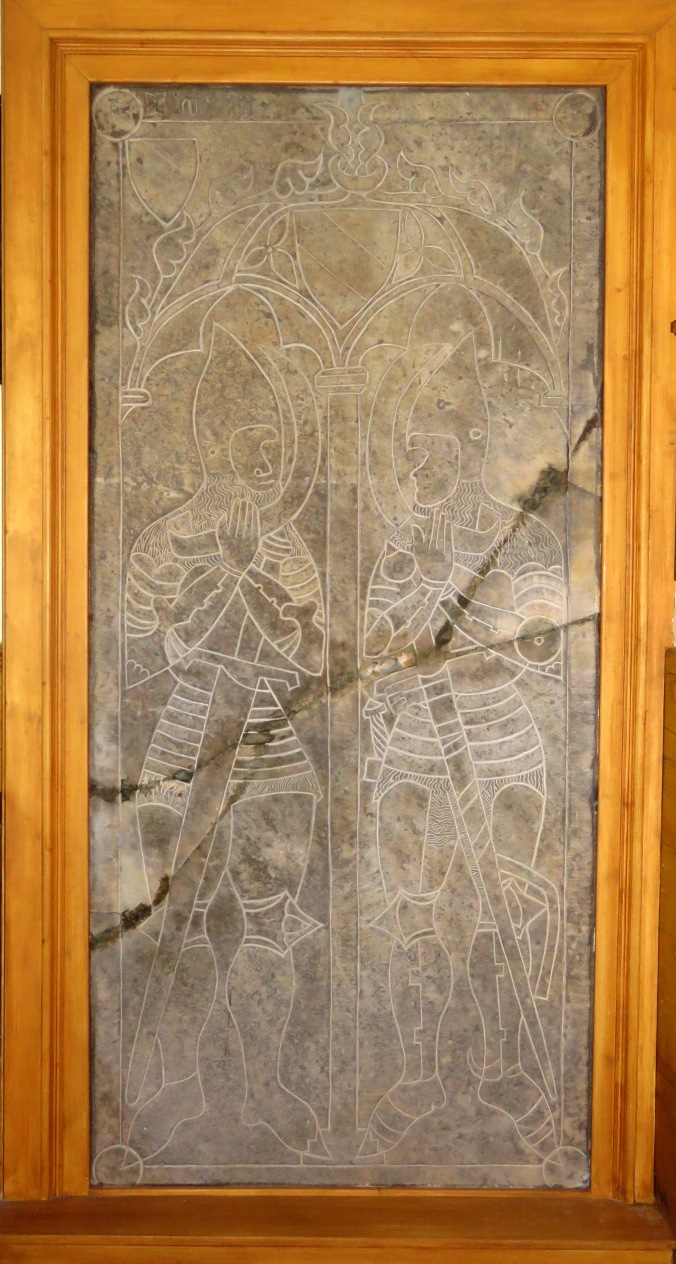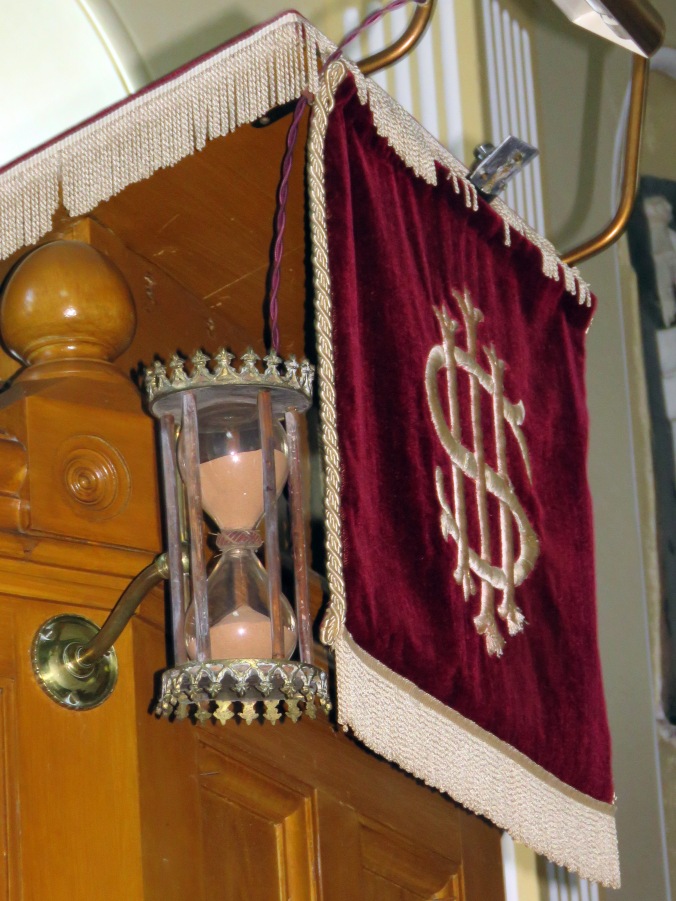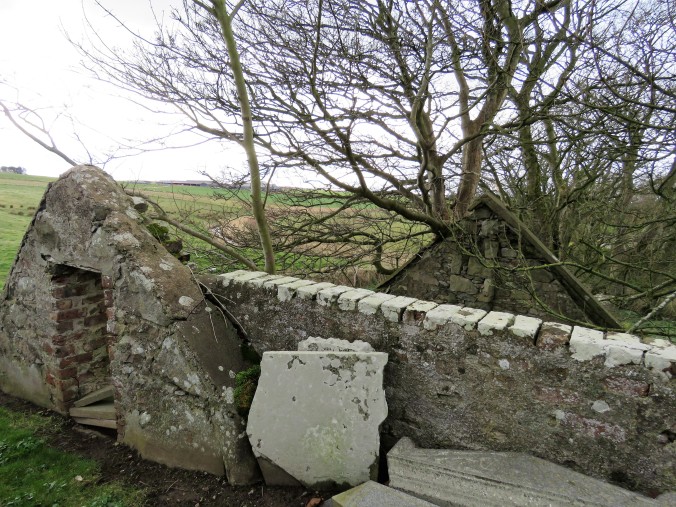 Unprepossessing from the outside, foursquare ‘Heritors’ Gothic’ and now sadly not in regular use, Foveran Kirk contains a treasury of remarkable monuments, chief of which is the medieval Turing Slab. The stone formed part of the Turing Aisle of the medieval church which was replaced by the present building in 1794. The Baronetcy of Foveran was created in 1638 for John Turing who was a supporter of Charles 1st and was taken prisoner by the Covenanters.
Unprepossessing from the outside, foursquare ‘Heritors’ Gothic’ and now sadly not in regular use, Foveran Kirk contains a treasury of remarkable monuments, chief of which is the medieval Turing Slab. The stone formed part of the Turing Aisle of the medieval church which was replaced by the present building in 1794. The Baronetcy of Foveran was created in 1638 for John Turing who was a supporter of Charles 1st and was taken prisoner by the Covenanters.
 The stone is occasionally referred to as the Crusader Stone since it was once thought that the two knights represented on the stone may have been brothers who died during a crusade to the Holy Land. However, the grey sandstone slab has many similarities to the stone at Kinkell commemorating Gilbert de Greenlaw who was killed at the Battle of Harlaw. This strongly suggests that it may be by the same craftsman and that the Turing Knights were also slain at Harlaw.
The stone is occasionally referred to as the Crusader Stone since it was once thought that the two knights represented on the stone may have been brothers who died during a crusade to the Holy Land. However, the grey sandstone slab has many similarities to the stone at Kinkell commemorating Gilbert de Greenlaw who was killed at the Battle of Harlaw. This strongly suggests that it may be by the same craftsman and that the Turing Knights were also slain at Harlaw.
There are no external remains of the original medieval kirk which belonged to the Abbey of Deer, the present building is supposed to have been built on exactly the same site as its predecessor. Foveran Church was not immune from the religious conflict which prevailed in the late 17th century when Presbyterianism replaced Episcopacy as the official religion of the Church of Scotland. The Heritors, who included the Earl Marischal, installed an Episcopalian minister, Rev. James Gordon against the will of the parishioners who made such strenuous efforts to have him removed that in 1692 they and a detachment of dragoons broke down the kirk door. The conflict continued until Rev Gordon was driven from the parish in April 1696.

Within the church are several imposing marble memorial plaques to local dignitaries, reflecting the importance of the kirk at the heart of the parish these include memorials to the Udnys of Udny. Attached to the pulpit is a beautifully preserved example of an hourglass – like those depicted on so many 18th century gravestones. It is thought that this example dates from that period and was mentioned in an inventory of 1774.
James Christall, son of Robert Christall of Mains of Foveran is recorded as having died at Belhelvie in March 1770. His corpse was left in the kirk there overnight but was removed by body snatchers. It was only on the intervention of the minister of Belhelvie that his body was recovered and returned to his own parish for burial. The ruin of the watch house which overlooks the southwest corner of the kirkyard testify to the fear of grave robbers which must have gripped the community after this gristly event.
 At first sight the grave of 18-year-old E. H. Thompson, ‘erected by his grieving parents,’ appears to commemorate an individual family tragedy. However, Thompson lost his life when the iron ship, Ben Rhydding, bound for Dundee from Calcutta with a cargo of jute and castor oil, sank off Blackdog with the loss of all 30 crew members. This was one of an horrific series of wrecks on the Aberdeenshire coast over the weekend of 5th and 6th March 1881 when 8 or 9 vessels were wrecked and around 200 lives were lost, 5 to the north of Aberdeen and 3 near Peterhead. Appallingly the Ben Rhydding ran aground within sight of the shore but the rocket apparatus used to attempt rescue could not reach the ship and the 30 crew were seen to be desperately clinging to the rigging for several hours until the main and foremasts masts gave way. All lost their lives. The same storm was responsible for very many tragedies along the North Sea coast.
At first sight the grave of 18-year-old E. H. Thompson, ‘erected by his grieving parents,’ appears to commemorate an individual family tragedy. However, Thompson lost his life when the iron ship, Ben Rhydding, bound for Dundee from Calcutta with a cargo of jute and castor oil, sank off Blackdog with the loss of all 30 crew members. This was one of an horrific series of wrecks on the Aberdeenshire coast over the weekend of 5th and 6th March 1881 when 8 or 9 vessels were wrecked and around 200 lives were lost, 5 to the north of Aberdeen and 3 near Peterhead. Appallingly the Ben Rhydding ran aground within sight of the shore but the rocket apparatus used to attempt rescue could not reach the ship and the 30 crew were seen to be desperately clinging to the rigging for several hours until the main and foremasts masts gave way. All lost their lives. The same storm was responsible for very many tragedies along the North Sea coast.